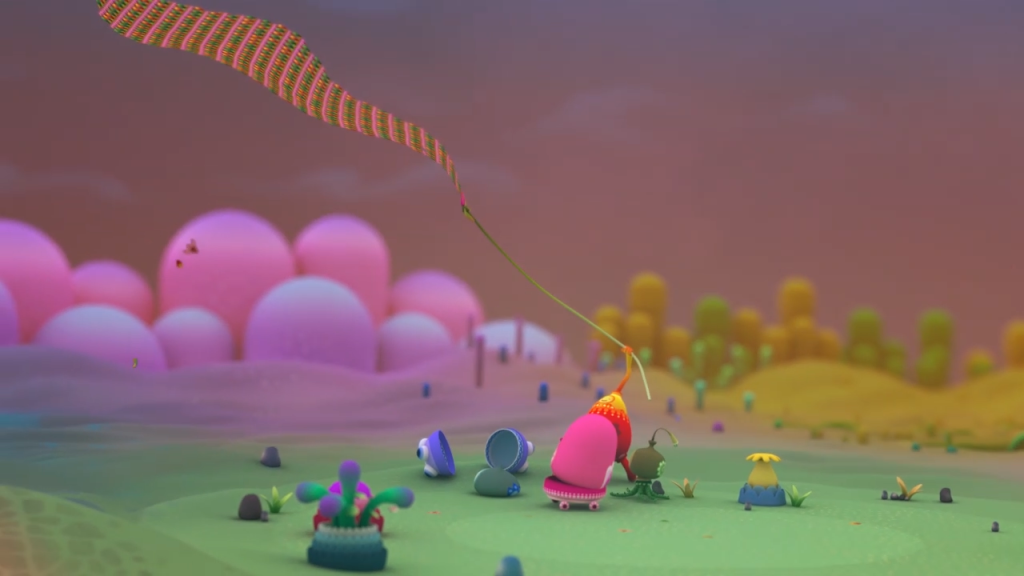
Leaf
Many adults would like to understand more about why buddi catches children’s attention so powerfully. Parents are understandably cautious about what material their children view. At Buddi World, we care deeply about our young audience and we want to provide parents with a deeper insight into why their children love our show so much and the positive things they are getting out of each episode. We will be publishing articles every Friday in order to provide insightful information about how Buddi has a positive educational and sensory impact on children.
We continue our weekly articles with episode five, “Leaf”.
Story
It’s a very windy day in Buddi Kotti. Vihi is swimming in a pond and Iso is standing under an apple tree which is losing all of its apples. Puna is having the most fun of all, running around chasing the flying leaves.
All of a sudden Cini has an idea: he wants his friends to hide him under a pile of leaves! The Buddis gather as many leaves as they can and they place them all on Cini’s head. Once they are done, Cini jumps out of the pile of leaves, causing all the other Buddis to laugh.
Kelta has another idea: he wants to combine all the leaves together like a puzzle and create one big and colorful leaf! They assemble the leaves together and, once they are ready, Kelta takes one end of the big leaf and raises it up high in the sky.
The wind is still very strong and it makes the leaves float and move in the air like a gigantic, colorful kite.
Leaf play
The episode “Leaf” revolves almost entirely around the topic of leaf play: the storyline is very simple, and the focus is much more on visual and sensory stimulation. Playing with leaves could be a great opportunity for your kids to learn about seasonal changes. Why do leaves change colour in autumn? Why do they fall?
There are many activities that can be done with leaves, here are some examples:
- Sticky leaf tree : Go on a leaf hunt and pick the ones you like the most. Draw the outline of a tree on a piece of paper and use the leaves you found to decorate your tree’s branches. You can secure them to the paper with some glue or tape. And there you go your own, personal tree!
- Leaf rubbings: place your leaves under a white piece of paper. With crayons or watercolours, have your child drawing over the leaves. This way, not only your child will be super proud of how accurate his drawing of a leaf is, but he will also get to know more about the parts of a leaf, such as the veins of the petiole.
- Leaf lantern: creating a beautiful lantern that reflects fall colours is easier than you might think. You just need an empty glass jar, some leaves and a tea candle. Take the leaves first, and spread some transparent glue on one of their surfaces. Once done, stick the leaf on the inside of the glass jar. Do this a couple more times with leaves of different colours. Once finished, add your tea candle on the inside of the jar and you will have your own, hand-made, personalised fall jar!
Peek-a-boo
The episode “Nest” features another beloved children’s game: peek-a-boo. We all know and have played this game, but have you ever wondered why children love it so much?
According to early childhood development expert Jeanette Sawyer Cohen, very young children love playing peek-a-boo because they lack what is called “object permanence”. This is a cognitive ability that toddlers only start developing after 6 months of age and it determines the capacity to know that objects continue to exist even though they can no longer be seen or heard.
Cohen claims that it is possible to understand if your child has started developing object permanence just by observing: “If she’s around 5 months old and drops a toy over the edge of the bathtub […] she probably will not look for it. It’s as if the object no longer exists once it’s out of sight. But, watch that same baby a month or two later, and she will now look around to find the lost object. Her searching behavior shows us that she has an idea in her mind that the item does exist even when out of sight.”.
Playing peek-a-boo with your child is therefore an amazing exercise to help him/her develop object permanence. Mastering this key cognitive skill will come in handy in situations where you and your child will have to be separated (eg. the first day of school). Knowing that disappearing from his/her sight does not mean to disappear forever will definitely ease separation anxiety.
Resources:
https://us.tomy.com/playing-presence-how-mindful-play-helps-your-little-one-grow
